The World Cup Showjumping Finals…
Christopher Hector and Gemma Alexander examine World Cup Finals breeding over four decades…
The Prologue – by Christopher Hector
1979
The first World Cup Showjumping final was in Göteborg in 1979. It was the inspiration of Swiss journalist. Max Ammann, with the blessing of the then president of the FEI, the Duke of Edinburgh, who saw it as a way of keeping professional riders, who were not allowed to go to the Games, within the FEI umbrella. Max wrote written countless books that are a wonderful source of information about equestrian sport, but alas, he does not seem to be much interested in the breeding of the horses, at least at the beginning of the World Cups, so we learn little of the breeding from his World Cup media guides, or the book, The Volvo World Cup – The first ten years. Max wasn’t alone, the FEI was supremely casual when it came to getting the breeding right too.
Later, Max, and Joep Bartels, who wrote the book, The World Cup Dressage – The First Ten Years, did become serious about detailing the breeding and the breeders of the horses, and helped introduce breeding details to start sheets as a matter of course.
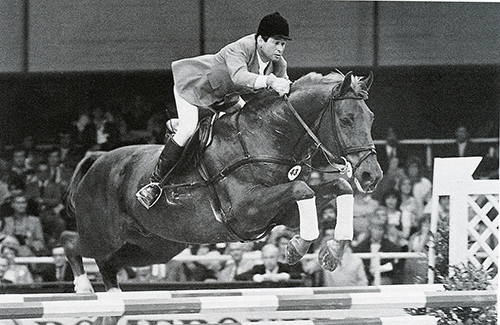
The first champions – Gladstone and Hugo Simon…
If we go to the hippomundo results for that first final, then you find the breeding of five of the 27 finalists, plus the wrong breeding for a sixth. The sire of Gerd Wiltfang’s Roman is listed as Romadour II, when the horse was by Romadour I. This is not trivial, since there is reason to believe that Romadour II was in fact by Dulft III, carrying the great dressage blood of Duellant, while Romadour I looked much more like Romulus I, a son of Radetsky, who is listed as the sire of both. It has been established that the dam was covered by both stallions…
Days of sleuthing later, I am able – hopefully – to identify the breeding of eighteen of the 27, and thanks to all who helped in the search.
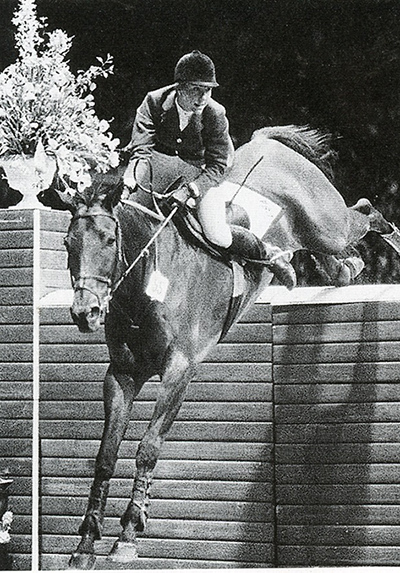
but they only just beat the Thoroughbred, The Jones Boy and Katie Monahan
Looking back from 2019, the standout is the number of Thoroughbreds, almost one third, eight out of 27, we can, with varying degrees of certainty call Thoroughbred (which makes ‘Thoroughbred’ the studbook with the largest representation), and there is more Thoroughbred up close. The two Selle Français in the final, had lots of blood, Val de Loire’s dam sire was a son of Orange Peel xx, while Faon Rouge’s dam was half Thoroughbred. Ryan’s Son was by Oxymandids xx, and if we ever find the breeding of the other Irish jumpers, then I bet we’ll find more Thoroughbred. I was a trifle amazed when I contacted Zangersheide to find the breeding of Romeo Z, to be told that 1979 was before the establishment of the studbook, so they couldn’t help. The late Léon Melchior might just be rolling in his grave since he took breeding and bloodlines, very very seriously.
At the time, many people just didn’t care how the horse was bred as long as it left up the poles. American jumping star, Bernie Traurig, replied to my query about the breeding of The Cardinal, somewhat forlornly:
Hi Chris, I’m sorry I wish I knew that information and I don’t know anyone who knows that information we all just assumed he is a Thoroughbred horse, breeding unknown. If you could dig it up I’d be very grateful.
Now, it is a bit late to find out.
It was also the era of the gelding, there is but one mare and no stallions on that first list.
1989
Ten years later, the final is in Tampa, and already there are serious moves to recognize breeders and bloodlines. As president of the FEI, Princess Anne called a meeting of sporthorse breeding experts, the year before the final, in September 1988, an initiative that resulted in the formation of the World Breeding Federation for Sport Horses in 1994 and the pressure was on the show organizers to include breeding information on start lists.
Still the list for 1989 is far from perfect. Hippomundo more or less identifies the breeding of 33 of the 46, we are able to take the total up to 42 and fill in a few gaps on the way.
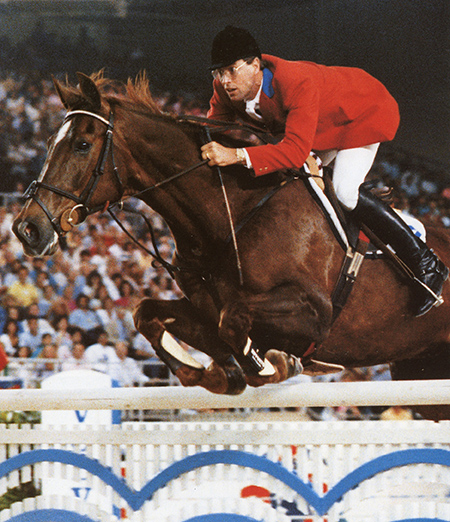
Big Ben and Ian Millar
The win for Ian Millar and Big Ben (Etretat / Flevo) signals the arrival of a new player, the Belgian Warmblood Society (BWP), a book that would become increasingly powerful in the world of showjumping. Amazing given that the Belgian Studbook was only started in 1953!
In the early days of establishing Belgian breeding, Selle Français stallions like Big Ben’s sire, Etretat (Vagabond / Protee xx, that’s 82.88% blood) were hugely important. The Belgian bred dam, Oekie (Flevo / Oregon) produced 14 foals between 1973 and 1989, eleven of those mares went on to produce an astonishing number of foals. The BWP was also represented by the stallion, Darco (Lugano van la Roche / Codex) who finished 12th and went on to be a hugely influential sire in Belgium and the face of the emerging Belgian breed on the international circuit.
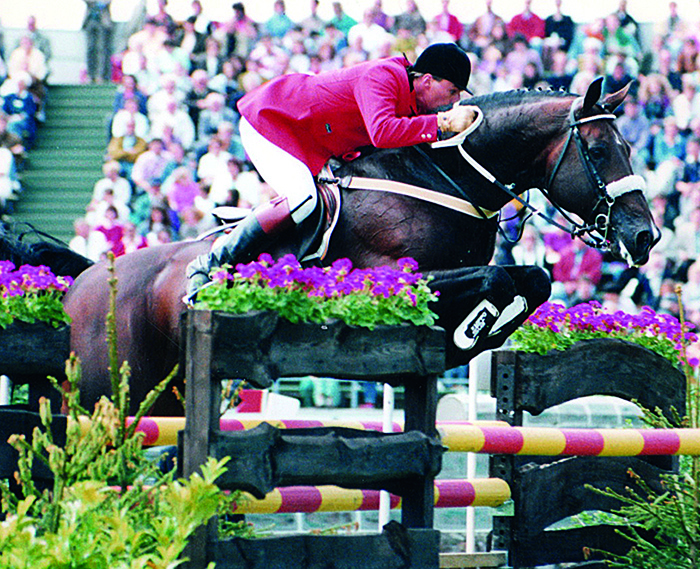
Darco – great jumper, great sire…
The Dutch breeders were also flexing their muscles, with eight into the final, headed by the immortal Milton (Marius / Any Questions aa). Still the Thoroughbreds were holding their own with six we can identify, followed by the Selle Français (5) and the Holsteiners (5).
1999
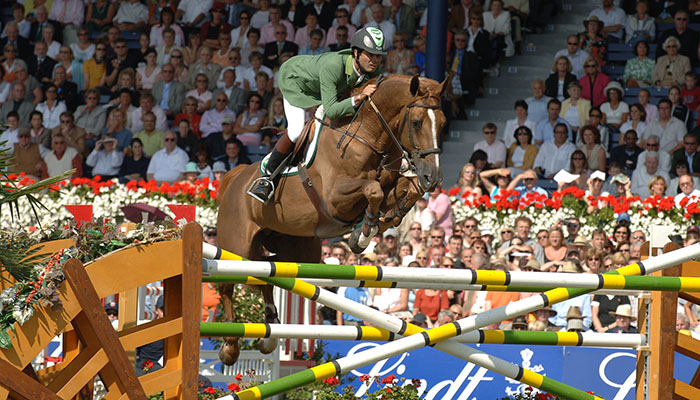
The winner in 1999 – Baloubet, number 2 of three wins…
In 1999, the KWPN still had the most representatives with eight, but they are being challenged by the Selle Français, lead by the World Cup champion of that year, Baloubet du Rouet (Galoubet A / Starter) taking the second of his three consecutive World Cup titles.
The sires whose progeny competed in 1999 constitute a Pantheon of Great Showjumping stallions: Polydor, Le Tot de Sémilly, Quick Star, Voltaire, Quidam de Revel, Jalisco, Cantus, Darco, Caletto II, Irco Marco and the great Pilot, who put two into the final.
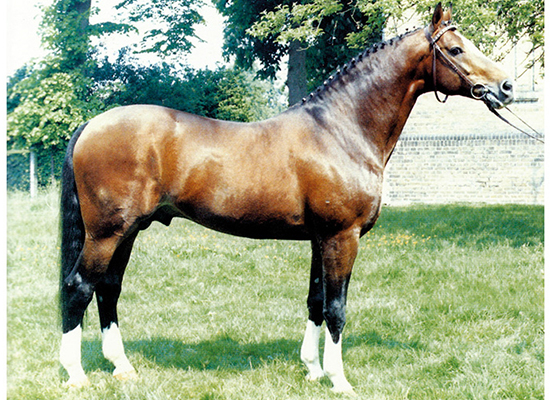
Pilot, his influence is still being felt
2009
The Hanoverian Jumper Breeding Program with the aim of preventing their breeders covering good showjumping mares with dressage stallions to meet the market, was launched in 1993, and has been highly successful in resurrecting jumping breeding in Hanover. The program was given a kick along by the victory of the Hanoverian gelding, Shutterfly, one of three Hanoverians to make the 2009 final.
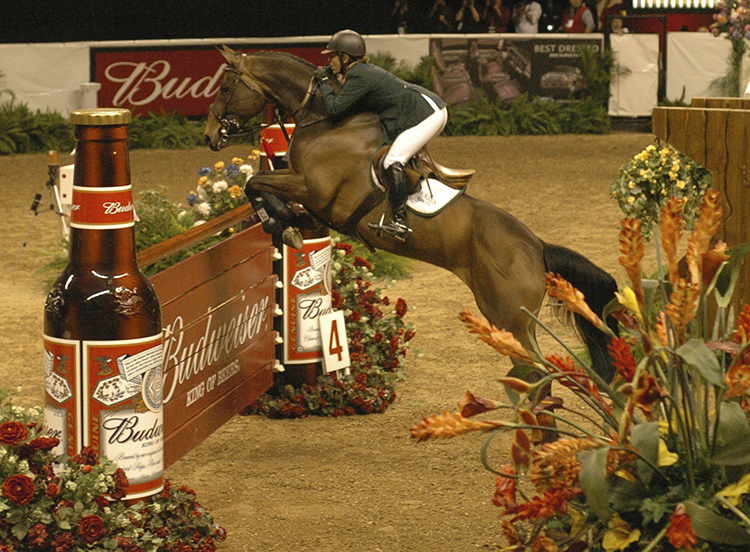
Shutterfly and the Hanoverians are back…
There were ten from the KWPN, the French book presented seven of the finalists and five from Holstein.
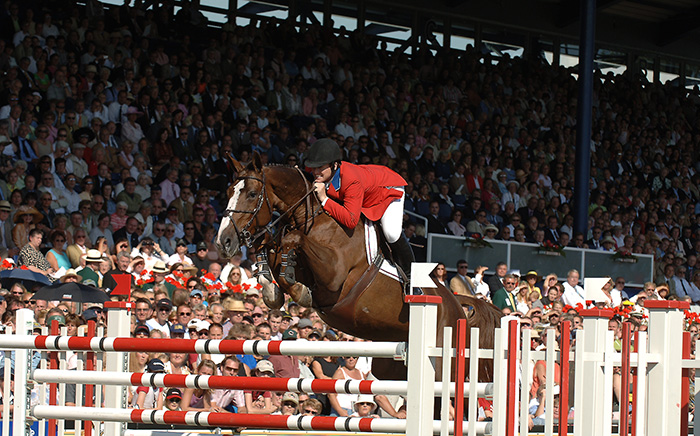
Sapphire and McLain Ward leading the Belgian contingent in 2009
The 2009 final also featured a stallion that was to go on to be one of the greatest of all time, the Belgian bred, Cornet Obolensky (Clinton / Heartbreaker), one of the contingent of four from the BWP, led by the mare, Sapphire (Darco / Hedjaz) who finished second.
It also highlighted the importance of Libero H – a World Cup champion in 1994, and a super sire. He put two horses into the 2009 final including the fourth placed LB No Mercy.
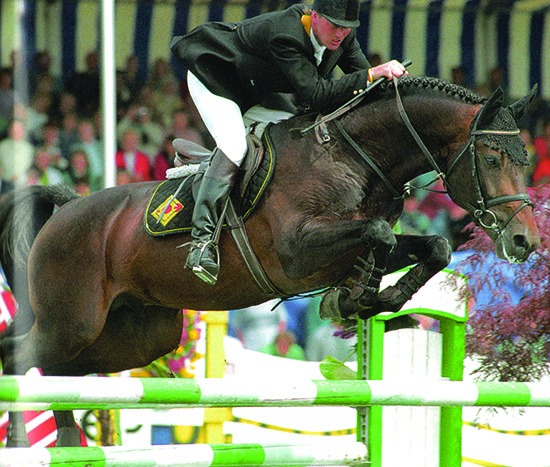
Libero H – World Cup winner and SIRE!
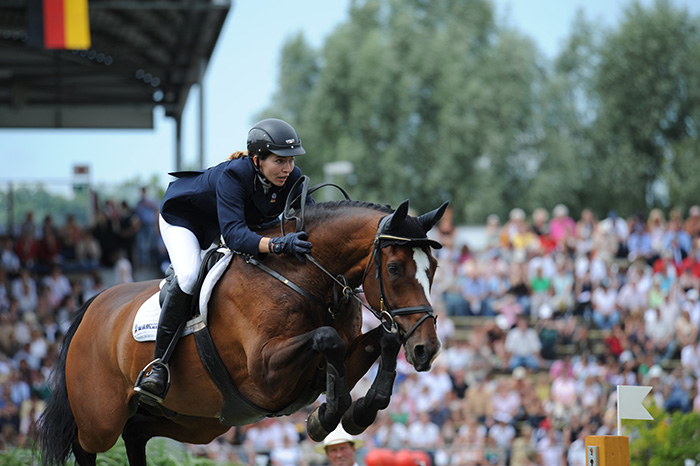
And his son, No Mercy, fourth in 2009
2019
Four decades ago, the largest breed group in the Finals was the Thoroughbreds, this time around, there is not one but I suspect that the total proportion of Thoroughbred blood running in the veins of this year’s finalists is higher than it was back then. As Arnaud Evain has pointed out, you don’t need to use full Thoroughbreds to keep the proportion of ‘blood’ high – if you mix a glass that is 50% gin with another with 50%, the proportion of gin is still half.
At least that was my theory before numbers whiz Gemma got to work and produced the numbers and proportions that you will find in her statistical analysis below.
The other feature of today’s jumping breeding is that the stallion heroes that were able to dominate the sport, have receded into the background, as there are now so many good stallions, that the work – and the results – gets spread around. Thus there are only four stallions with more than one representative: Toulon and Chacco-Blue, with three, Kashmir vans Schuttershof and Caretino, with two.
Much has been written about Chacco-Blue, Kashmir and Caretino, but Toulon is the quiet achiever of the group. While Chacco-Blue heads the WBFSH rankings for the second year in a row, and Kashmir slides up from sixth to fifth, Toulon, leapt into this year’s top ten, up from 16th to seventh. Sixty eight of his progeny contributed to his points total of 10,943.
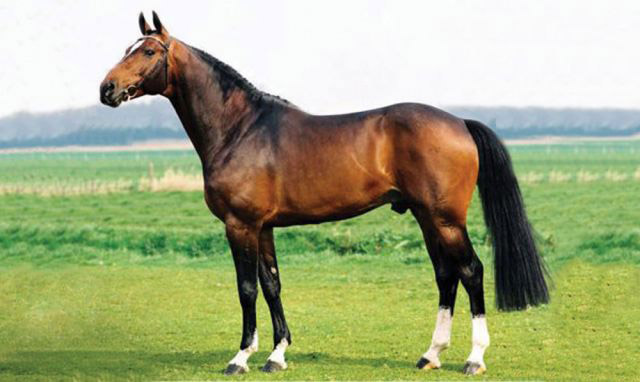
Toulon…
Toulon is by the great sire Heartbreaker. The dam’s sire Jokinal de Borvinal is a son of Almé – he was shown by Ludo Philippaerts for two seasons, with wins at Mechelen (twice), Millstreet, Oslo and Bologne. Jokinal is out of a Rigoletto mare – Rigoletto was the most important source of the blood of the Anglo Arab, Ramzes in Holland.
Toulon’s pedigree also has two crosses of the Irish Thoroughbred, Uppercut, who was granted Preferent status by the KWPN. Uppercut was the sire of sixteen approved sons, and the dam sire of eight more – including Aram, the sire of the individual gold medallist at the Sydney Olympic Games, De Sjiem.
Toulon’s international jumping career with Frenchman Hubert Bourdy included a win in the Global Champions Tour in 2007 in Sao Paulo.
Just as the sire’s credits are shared around, so too are the studbook results. The BWP takes the lead with seven, Holstein has six, as does the KWPN, though sometimes brands obscure blood, and their is a rich vein of Holstein blood flowing on the top and bottom lines of the Dutch horses.
OS (the Oldenburg jumping book) has four, and is once again punching above its weight, the French, four, while Westfalia and Zangersheide, have three.
If you are wondering about the SLS affiliation of the defending champion, Beezie Madden’s Breitling LS, it’s Studbook La Silla, founded by Alfonso Roma in Mexico in 2001. Beezie’s horse is capable of causing data-base chaos, since occasionally you come across a reference to Wolfram Wittig’s great dressage stallion, Breitling being ridden by Beezie. One should note, that Beezie no doubt would do a splendid job, schooled as she is in very superior flatwork by her mentor George Morris, and that’s the other thing that has changed in four decades, the riding styles have merged and you see none of the stylistic eccentricities of yesteryear. I can say that because Bosty didn’t make the cut this year…
next we discuss the dressage horses
The Dressage World Cup
1986
The first winner was a Danish Warmblood, Marzog. Celia Clarke and Debbie Wallin in their The International Warmblood Horse noted back in 1991, that “the aim of the Danish breeders is to produce a very harmonious animal with well-proportioned modern lines. Great attention has been taken to improve the wither and shoulder and thereby the walk and canter by the use of Thoroughbred blood. Swing and elasticity, with shoulder freedom and suppleness through the loin, rate very highly in the Danish grading process, as does the use and flexion of the hind limbs.”
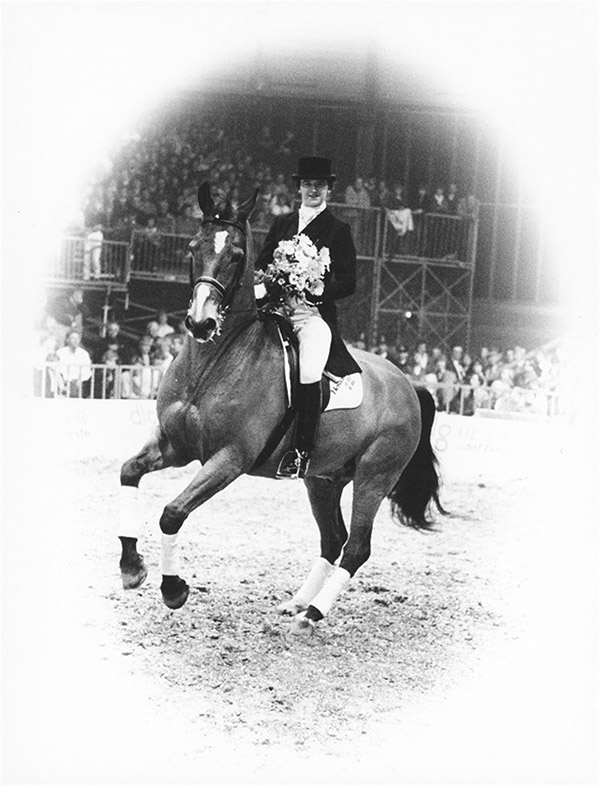
Marzog, won the first World Cup final
Marzog’s sire, Herzog (Heristal / Samos) was one of three Swedish full-brothers, that helped consolidate Denmark’s mare band while at the same time, producing a good number of competition horses. Herzog was by the Trakehner, Heristal, with more Trakehner blood on his dam line, while Marzog’s dam, Cheeky Girl was by Marcio (Aventin xx / Janus xx), the Thoroughbred that did so much to refine the horses of Hanover.
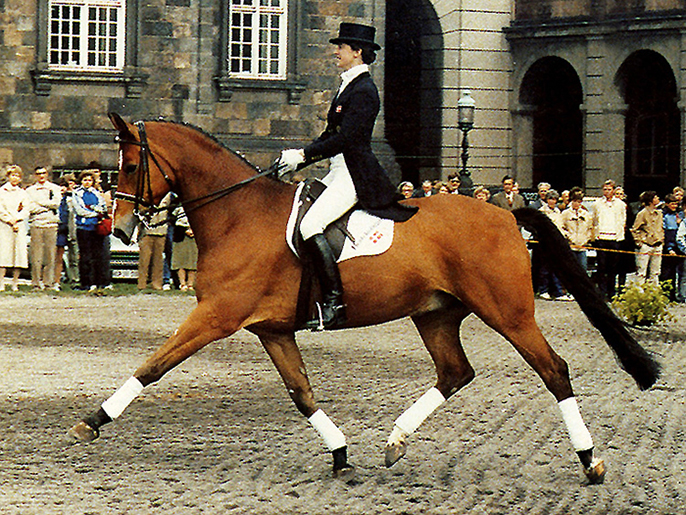
Marzog may have been only 31.25% blood, but the Trakehner also contributed to his modern, elegant look, especially when the preferred dressage model up until then had been tanks like Granat.
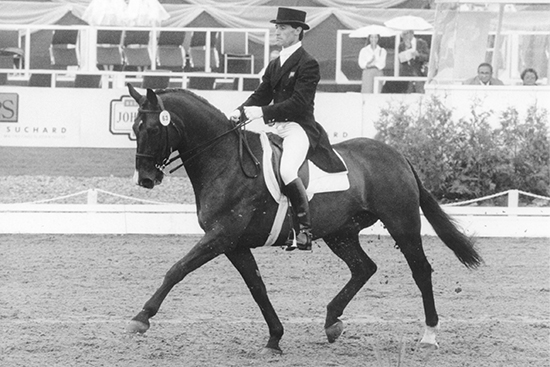
Take your eventer to a World Cup Dressage Final – why not? Wily Trout
Certainly the second placegetter, Wily Trout was anything but purpose bred for dressage. He was by the Thoroughbred stallion, Wily Trout (Le Sage xx / Panorama xx) out of a mare that Christopher Bartle tells me was ‘believed to be three quarters Thoroughbred’. Christopher had an eventing career in mind for Wily Trout, until a dodgy tendon saw them switch to dressage and fame and glory. You can’t quite imagine it happening now…
Third placed Rubelit, was by the Trakehner, Unkenruf, and the Trakehners really had something of a head start in this new fangled dressage breeding caper, since they had always been riding horses and never used for agriculture, but still the Oldenberger dam line is a right mix, Holsteiner, East Prussian, Hannoverian and traditional Westfalien.
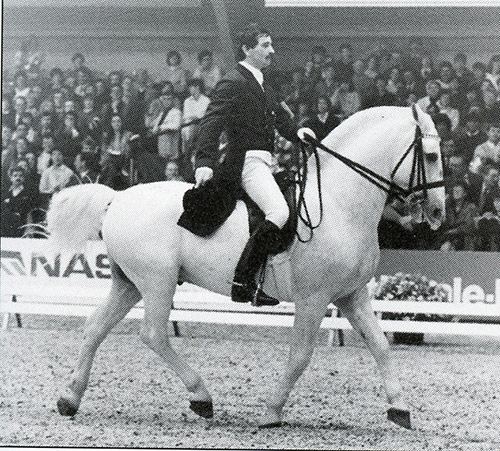
Purpose bred, Maestoso Monteaura and Alojz Loh
Really the only two purpose bred dressage horses in the final were the two Lipizanners, Maestoso Monteaura and Pluto Canissa. It is sad that with the fall apart of Yugoslavia, these cute little greys with the tall riders with even bigger moustaches, have disappeared from the scene.
1989
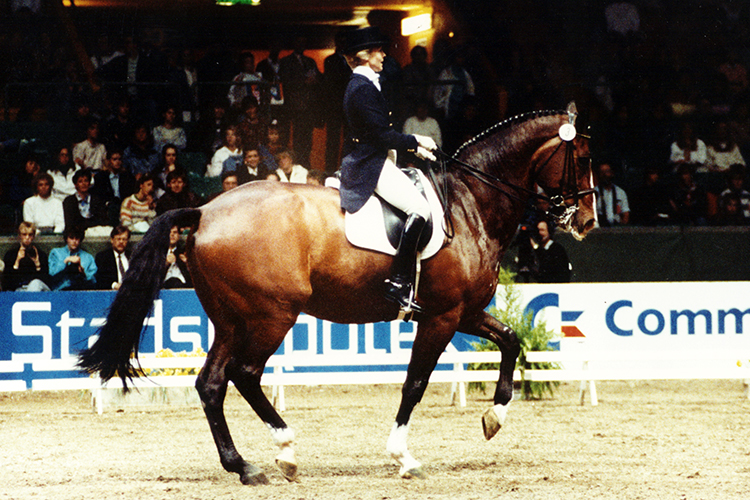
Three years later, at the 1989 final, those of us lucky enough to be sitting inside the Scandinavium in Göteborg, thrilled to the power of Corlandus, and the elegance of his rider, Margit Otto-Crepin, but there was nothing in the big bay’s lineage that says ‘dressage’ – in fact, everything says jump: by Cor de la Bryére out of a Landgraf mare.
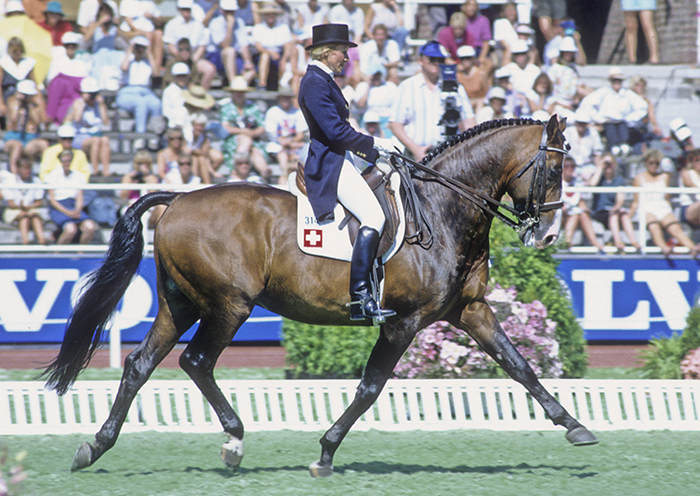
But the stallion that placed second, Gauguin de Lully, was definitely bred for dressage because that is what the vast majority of Swedish breeders concentrated on at the time. His sire, Chagall was a dressage producer, but the dam sire, Gaspari took it one step further and became the first dressage sire to also star in the competition arena.
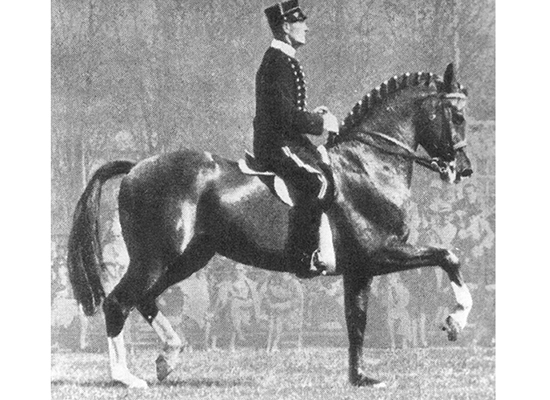
Gaspari
Gaspari is one of the horses credited with saving the Swedish breed by finding a new market as horses were phased out of the ranks of the military.
Luckily the famous trainer at the Swedish National Stud, Flyinge, Yngve Viebke came up with the perfect sales strategy – we’ll take our top stallion to the Olympic Games and show the world what we can do! Gaspari starred at Rome in 1960 and suddenly riders were coming from all over the world to buy his offspring. Once again mares were being bred, but this time to produce sport horses.
Gaspari also competed at the 1964 Games, and sired the individual gold medallist at the 1972 Games, Piaff. The Swedish horses dominated the 1989 final, aside from Gauguin de Lully, there was Chirac in fifth, and Reipo, sixth.
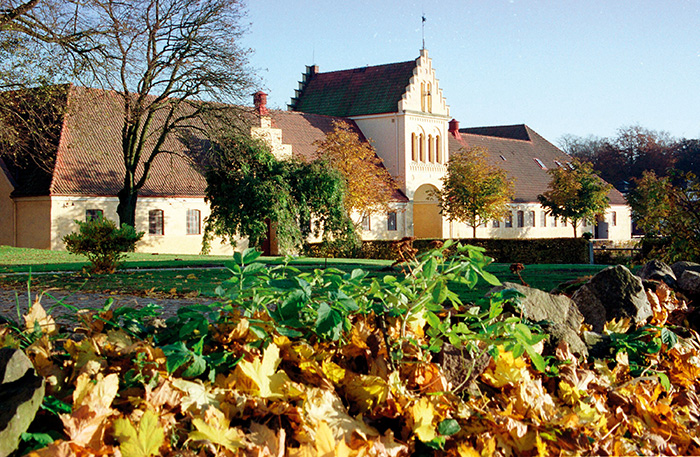
The Stallion Stables at Flyinge
It is somewhat surprising that the Swedish ascendency lasted for such a short time and came to such a sorry end with the historic stud at Flyinge no longer a stud but rather an equestrian centre. My feeling, visiting Flyinge in the 80s was that the horses reflected the rather bureaucratic management structure – nice horses, safely bred horses, but as the demand came for more flamboyant dressage horses, breeders in places like Oldenburg and The Netherlands, were more likely to take chances and produce the somewhat over-the-top individuals that came to dominate the sport for a while.
At that 1989 final, the American rider, Kathy Connelly rode Enterprise, breeding unknown. I asked my pal Ilse Schwarz, a friend of Kathy’s, if she could find more, The response is typical of the breeding blindness of the time…
Ilse writes: “There is quite the back story to his purchase and ultimate appearance in the World Cup finals. He actually doesn’t have any papers! He was shipped to her from Denmark with a passport with the generic name “Caballo” on it. She BELIEVES he is by the Danish Stallion Alexander (not sure if that is how it is spelled) out of a Thoroughbred mother, but has no actual evidence, other than his resemblance to the stallion, to support that!”
next the figures
1999
Ten years later and we are starting to see the results of a breeding program in Hanover that was to make the Hanoverian the model of a modern dressage horse, and success was to come largely through the influence of the Thoroughbred.
In a ground breaking piece of research, Florian Sitzenstock from the University of Goettingen, showed how dressage ability needed an infusion of Thoroughbred blood. The study examined the pedigrees of a total of 217,475 Hanoverian foals from 1980 until 2006 and found that the average proportion of Thoroughbred blood in the foals was 23%, with an increase from 20% in 1980 to 25% in 2006. During that period, the percentage of horses with no Thoroughbred blood, dropped from 40% to 4%! And as we can see from this graph, an increase in Thoroughbred blood shows an increase in the dressage value:
Integrated Breeding Value for Dressage and Jumping in relation to TB influence
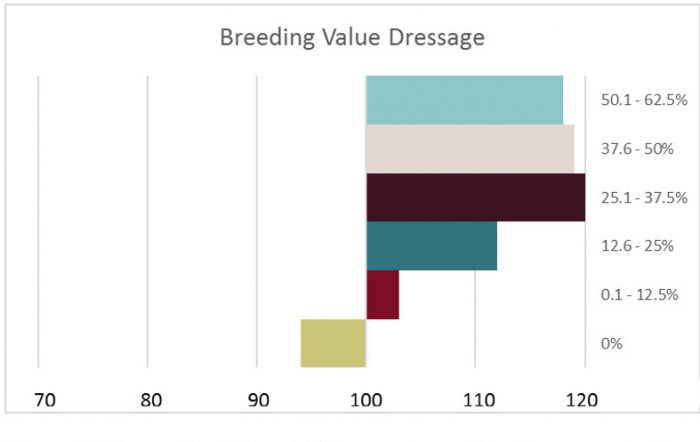
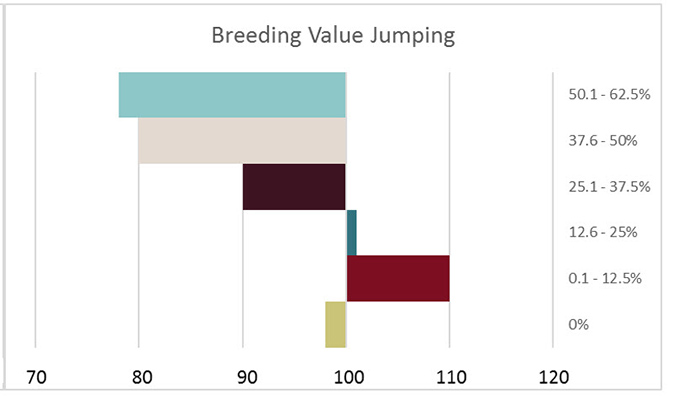
Above 100 is positive below 100 is negative value. The group in the population with the 3rdhighest % of TB blood (25.1 – 37.5%) had the best score for dressage, while the group with the highest % of TB blood (50.1 – 62.5%) had the worst score for jumping
The results of Florian Sitzenstock’s researches were published in the July 2009 edition of Der Hannoveraner.
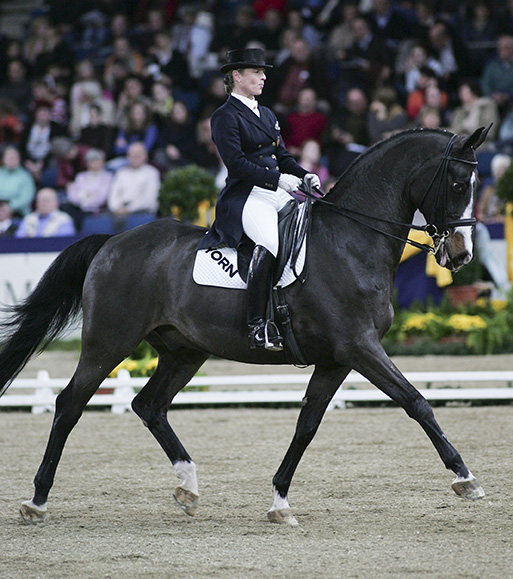
Isabell and Antony – the Hanoverians come to the fore…
Argument was a black Trakehner stallion with a distinctive white blaze. He was popular in Hanover, where he was the sire of Isabell Werth’s Antony, who placed second in 1999. Antony’s dam sire, Wenzel was one of the first of the Hanoverian bred dressage specialist sires,with 612 competition horses in Germany alone, with winnings of DM880,000 – almost all of that in the dressage arena.
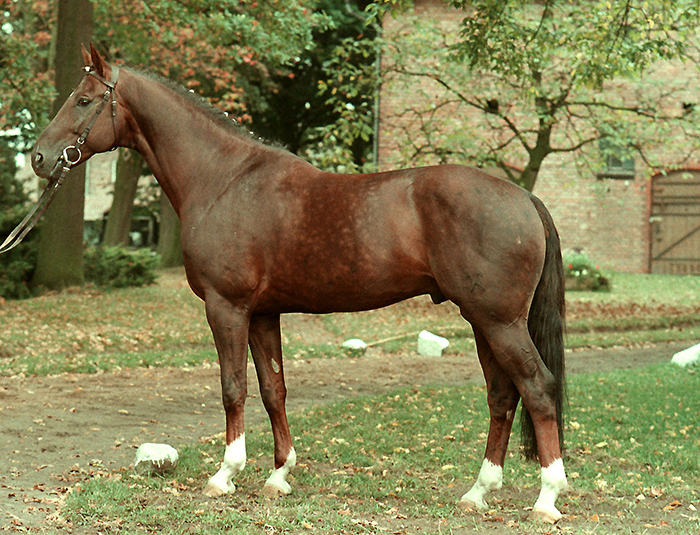
Wenzel
On the World Breeding Standings he had seven international competitors listed, which put him 10th on the rankings for the period 1992-2001. Wenzel was out of a mare by Matador, a very good Hanoverian grandson of the superb Marcio xx.
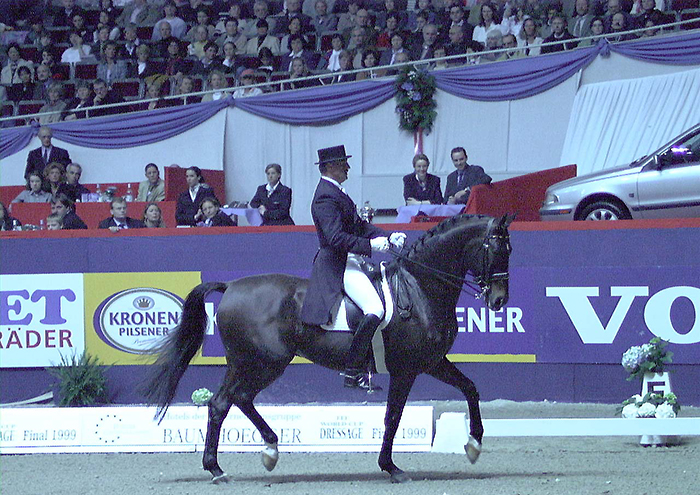
Jürgen Wirths and Souveraen W, another Hanoverian
Another Hanoverian took fourth, Jürgen Wirths’ Souveraen W (Salut / Wohlgemuth) while the Canadian rider, Dana Hewett was 13th on Enfatico, described as a Hanoverian but of unknown breeding.
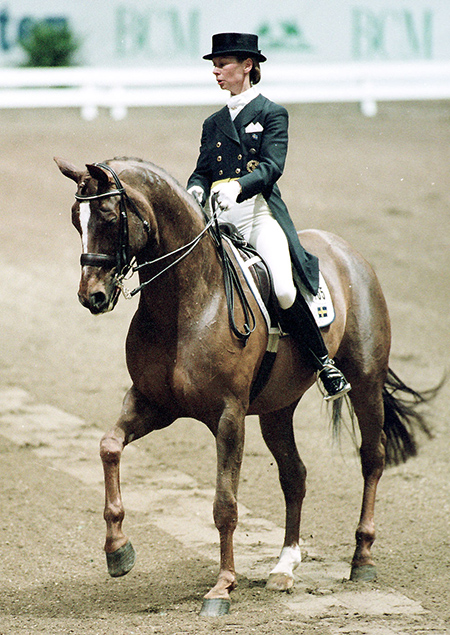
Hanoverian, Walk on Top and Louise Nathhorst, winners in 1998, but 14th in 1999
Surprisingly in 14th place was another Hanoverian, the previous year’s winner, Louise Nathhorst’s Walk on Top, by our old pal, Wenzel, out of an Absatz mare, reminding us that it was not just the Thoroughbred blood that renovated the Hanoverian, the Trakehners that arrived after the second world war, also played a vital rôle.
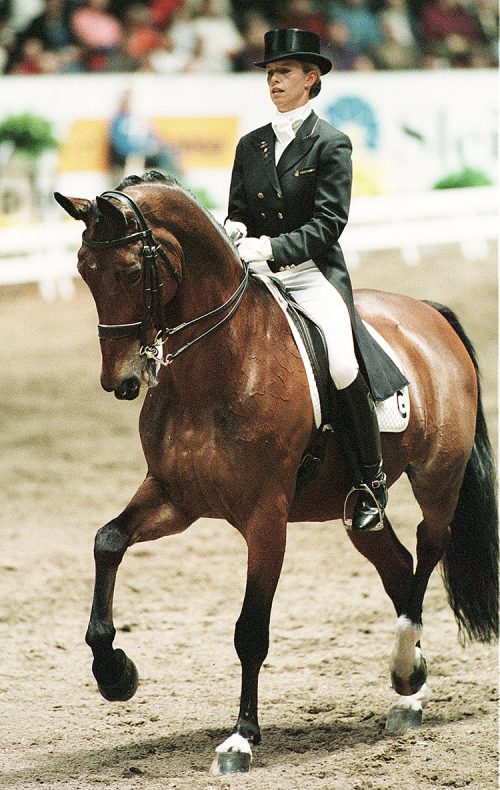
Anky van Grunsven and Bonfire
The winner – Bonfire – bore the brand of neighbouring Oldenburg and the breeders in that district were feeling their way towards the dressage formula. His sire, Welt As is perhaps best remembered as the dam sire of Paul Schockemöhle’s number one brood mare, Loretta (Ramino), dam, amongst others of Sandro Hit, Diamond Hit and Royal Hit. Bonfire’s dam was the product of Präfectus xx (Primera xx / Major Portion xx) one of the wonderful band of Thoroughbred stallions that transformed the Oldenburger from coach horse / work horse to modern sporthorse. He stood at the famous Vorwerk stud from 1971 – 1975.
2009
How quickly the breeding scene has changed in 23 years, look at the 2009 finalists and you see horses that are definitely bred for dressage, by stallions that were to shape the sport for decades.
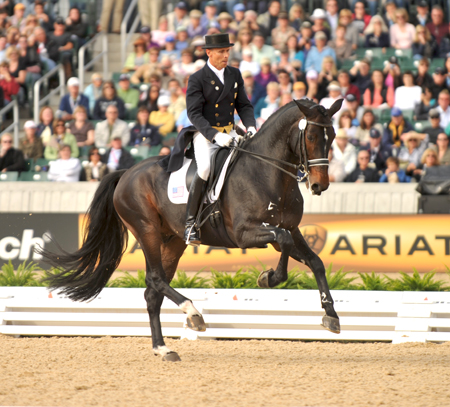
The winner was Steffen Peter’s Ravel by Contango out of a Democraat mare. Contango’s pedigree is not particularly ‘dressagey’, he’s by the great Holsteiner jumping sire, Contender out of a mare by another of those Thoroughbred imports to Oldenburg, Krönprinz (Nizam xx / Kaiserkrone xx). Contango really was the one that got away, Oldenburg lost him to The Netherlands, where he only stood a couple of season before moving to the United States. His influence has been enormous on both continents. Lucky breeders didn’t know he was a WFFS carrier..
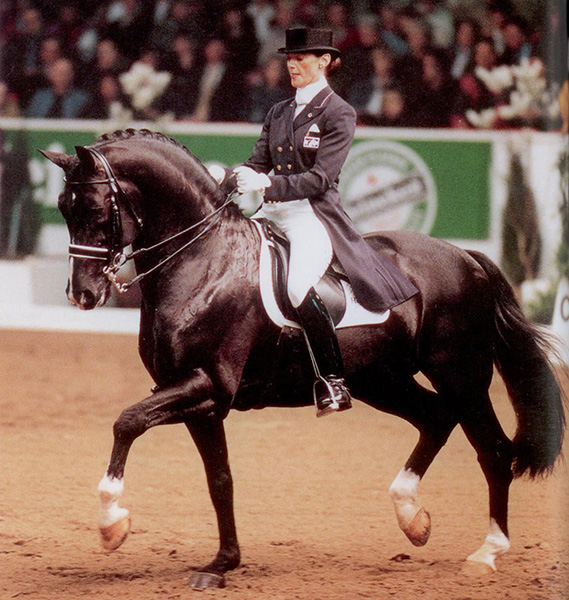
Ferro, important modern Dutch dressage stallion, with Coby van Baalen
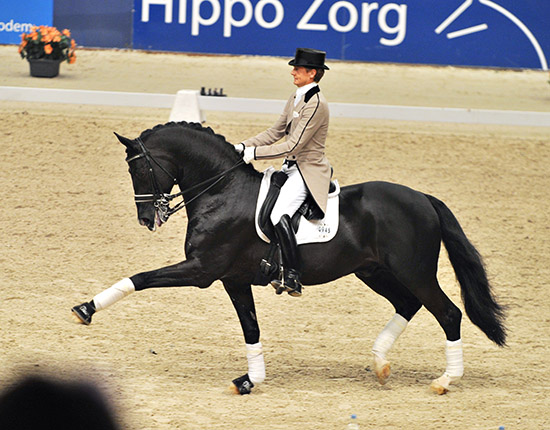
Gribaldi, sire of Totilas, also features on Painted Black’s pedigree
The reserve champion, Painted Black, combines two of the most important modern Dutch dressage stallions, Gribaldi and Ferro, and he is now proving a handy sire himself. Indeed this was a year in which the KWPN broadcast its dressage prowess, with six of the 14 finalists, wearing the Dutch brand.
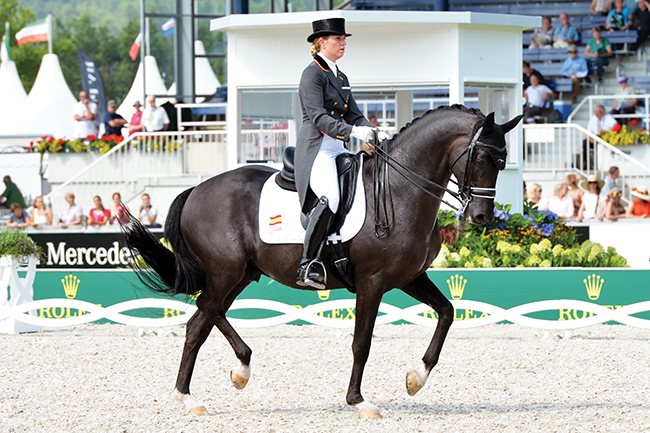
Painted Black
This is also a year where one of the strongest modern breeding trends is in evidence, Grand Prix competitors breed Grand Prix competitors: Contango, Partout, Jazz, Welt Hit I and Rubinstein are all represented in the line-up along with Gribaldi and Ferro.
Next we discuss the 2019 entrants
2019
This year’s line up sees the KWPN the best represented with six, Oldenburg is responsible for five, while Hanover contributes three.
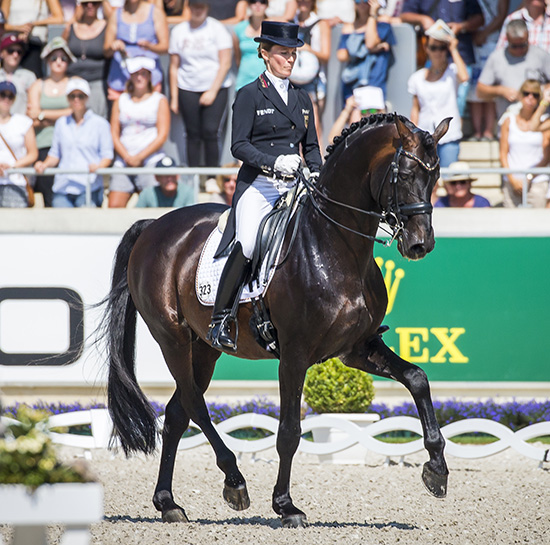
Damsey
Now the level of purpose bred breeding is approaching 100% top AND bottom, with just two exceptions. The Hanoverian stallion, Damsey FRH is by the dressage stallion, Dressage Royal (Donnerhall / Rubinstein), but out of a mare by Rituel, a son of the jumping sire, Ramiro, out of a mare by Grande, a stallion from the pre-specialisation era.
The other glaring exception is the American representative, Verdades. His dad, Florett As (Florestan / Urofino), is very definitely dressage, and competed Grand Prix with Patrik Kittel, but his mum is essence of Dutch harness horse, with countless crosses to the most famous Dutch harness stallion of them all, Oregon, and three crosses of the Hackney, Cambridge Cole.
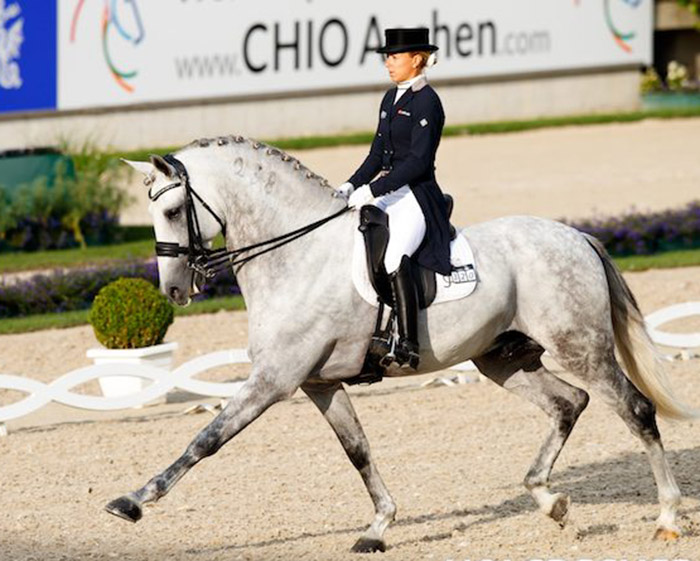
Even the Lusitano, Coroado is purpose bred. His sire, Rubi (Batial / Xaquio CIP) was a fine Grand Prix dressage horse, and competed at the London Games, and Maria, can thank her father, Paulo, one of Portugal’s most famous bull-fighting riders, for the mare line…
Paulo told me:
“I started breeding horses in the 1975. I was already a rider, a young rider, but I started very early. My uncle was a rider and bred horses and then I started by my self. I started by buying, in my opinion, some of the best mares Portugal had at that time. They were bull-fighting mares, Lusitano mares, but they were mares with the kind of movement that I looked for. The most important of these mares, and of all the horses of this time, was Quieta. I bought her when she was six years old. She gave three very important sons – Xaquiro, Altivo and Capote.”
“Altivo was a fantastic horse, he could canter doing one tempi changes towards the bull, twenty flying changes and then relax perfectly. He had such nice movement, swing in the trot, he already was a dressage horse. So I started to breed with him – nowadays his genetics are still in dressage, for example his son Altaneiro is one of the best Grand Prix Lusitano horses competing in Spain. Then there was another son, Capote – he was bigger, with more ‘blood’. I sold this horse to a very important breeder in Portugal – José Manuel de Mello. Altivo gave also another important son, Jalisco, who went on to the Grand Prix champion of dressage in Belgium. He was one the first Lusitanos to make a real name in dressage. Everything came from Quieta, she was big for a Lusitano in those times. Super swing, a ground covering canter.”
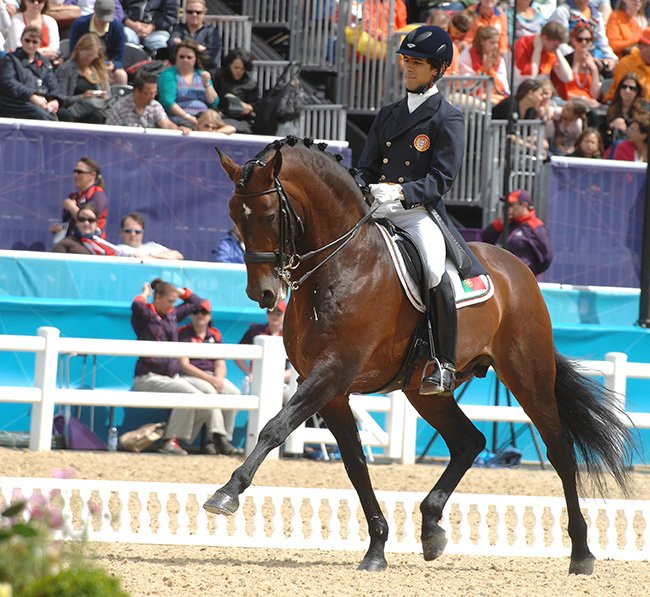
Rubi representing Portugal at the London Olympics
Maria’s Grand Prix stallion, Coroado, he is by Rubi, whose dam sire is Xaquiro, out of Luxelia, who is by Xaquiro.
Paulo sums up: “My beginnings were with a classic master – Viconde da Corte – and he would always talk about the quality of the movement and the lightness of the horse, and that is why I chose this mare. This is the basis of my breed, and the basis of nearly all good dressage horses in Portugal.”
As usual the D line of Donnerhall dominates, although Sandro Hit has confounded the expectations of those of us who thought he’d never make a Grand Prix horse, with a fine line up.
Donnerhall is the dam sire of Sir Donnerhall II by Sandro Hit, and his D line is responsible for six of the sires of this year’s finalists. Sandro Hit is the sire of two finalists, as is his son, San Amour.
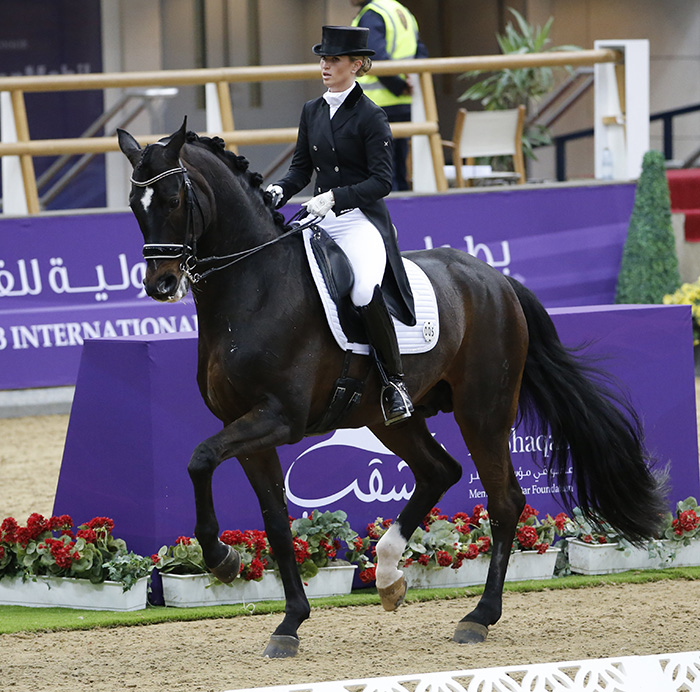
Sir Donnerhall II – S and D combine…
Although I expect we will continue to see the judicious use of some jumping lines to keep the athleticism required in the future, we are now well and truly in the era of the specialised dressage horse, how quickly things can change in four decades!
Enough from me, over the Gemma and more of her ground-breaking statistical analysis…
The Nitty Gritty with Gemma Alexander
SHOWJUMPING TRENDS 1979 – 2019
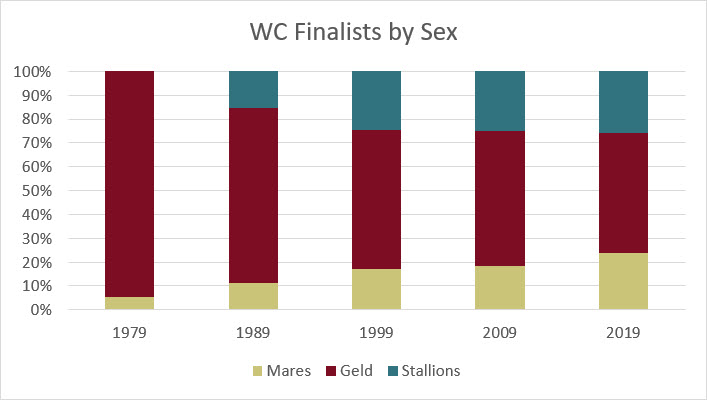
First off, let’s look at the World Cup Finalists by sex. The first WC Final really was the year of the geldings, represented by all but one entrant (a mare – Katapulte: Orphelus de Mesnil x Dosa, ridden by Christian Huysegoms of Belgium). Year-by-year the prominence of both mares and stallion entrants in the WC Finals has been increasing; by 2019, 24% of entrants were mares and 26% were stallions. This trend is likely due to the multi-purpose careers available to performance horses these days; horses no longer have to be put in either the breeding barn or the competition stable. In fact today there is increasing importance being placed on both the sire and dam having a proven competition record.
The average age of entrants in the WC finals has trended slightly upwards over the forty years; in 1979 and 1989 the average age was 11 years, while in 1999, 2009 and 2019 it increased to 12 years. Personally I found this somewhat surprising as it seems to me that horses seem to be hitting the big leagues at increasingly younger ages, but alas the statistics have proven me wrong.
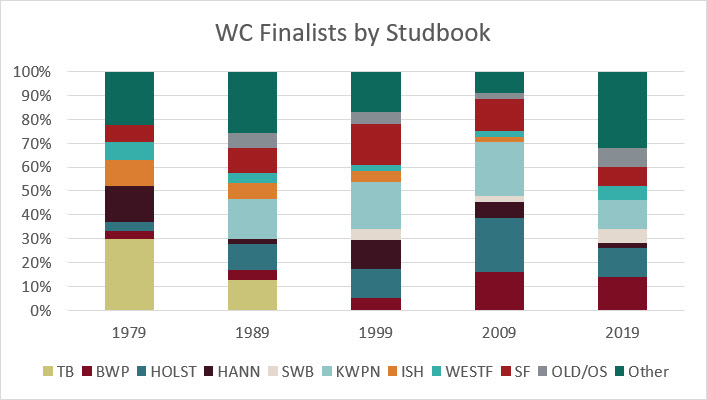
The breakdown of entrants by their registered studbook has also evolved over the last forty years. In 1979 the dominant registry was Thoroughbred, followed by Hanover, ISH, Westfalia and SF. By 1989 the influence of the Thoroughbred was diminishing, being the equal second-highest-represented studbook along with Holstein, with the KWPN being the most represented that year. 1999 again saw the KWPN dominate, followed by SF, and Holstein and Hanover tied for third. 2009 saw KWPN and Holstein tied as the leading studbooks, followed by BWP and SF. 2019 sees the highest number of representatives being from the BWP, with Holstein and KWPN tied for second; 2019 also sees a significant jump in ‘other’ studbooks in the startlist: we have four from Zangersheide (surprisingly this has been the only year analysed that had more than two representatives, I thought they would have been better represented), SBS had three, and then we had single representatives from a number of somewhat obscure studbooks including SLS (Studbook La Silla; it would appear the Mexican breeding behemoth has created their own studbook), SP of Poland, LHBA (Latvian Warmbloods) and DSP (previously known as the Bavarian studbook, and who has increased in prominence after DSP Alice took out the incredible individual win in Tryon). To me the increasing number of ‘other’ studbooks being represented at the World Cup Final is evidence of just how international the sport is becoming at the top level; a horse can be bred literally anywhere in the world, and make it to the top with a rider from any number of countries. I find this a really exciting development for the sport!
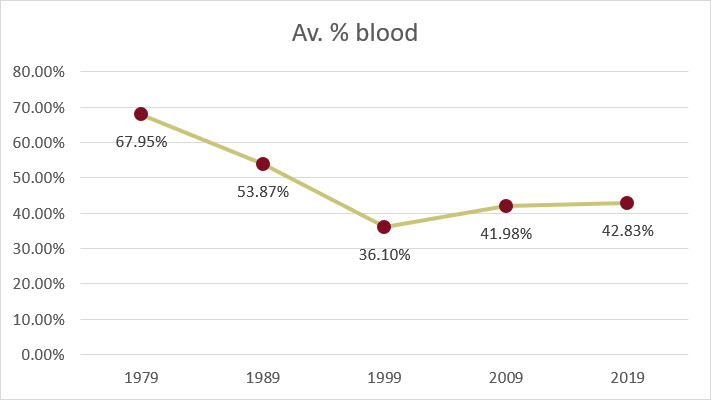
There is no surprise that the average percentage of blood was at its highest in 1979 at 67.95%, for this is when we had the highest number of full Thoroughbred entrants. By 1989 this had dipped to 53.87%, with still a few in the start list being full-bloods. 1999 saw the average blood percentage drop to its lowest level seen over the study period, at 36.10%; it is likely that this is when breeders and riders began to realize that for modern showjumping we need more than just brute strength, speed and agility also needed to be nurtured. Thus we saw an increase in the blood level over the ten-years to 2009, where it reached 41.98%; this remained virtually unchanged in 2019 at 42.83%; have we now found our sweet spot?
JUMPING START LISTS
1979
http://www.horsemagazine.com/thm/wp-content/uploads/2019/04/J_1979-1.pdf
1989
http://www.horsemagazine.com/thm/wp-content/uploads/2019/04/J_1989.pdf
1999
http://www.horsemagazine.com/thm/wp-content/uploads/2019/04/J_1999.pdf
2009
http://www.horsemagazine.com/thm/wp-content/uploads/2019/04/J_2009.pdf
2019
http://www.horsemagazine.com/thm/wp-content/uploads/2019/04/J_2019.pdf
Riders confirmed with multiple WC horses highlighted
DRESSAGE TRENDS 1986 – 2019
Like the jumpers, over the years the Dressage World Cup Final start lists have been dominated by geldings. Interestingly, the proportion of mares has remained largely unchanged over the forty years, while stallions hovered around 25% of entrants until 2019 where they make up a massive 55% of all starters. Of the ten stallions in this years’ start list, seven are fully licensed: Blue Hors Zack (Rosseau x Orana – Jazz), licensed for KWPN, Holst, Hann, SWB and DWB; Sir Donnerhall II (Sandro Hit x Contenance – Donnerhall), Oldenburg, Rheinland, SWB and SATHU; Damsey FRH (Dressage Royal x Ria Grande – Ritual), Hann, SWB, SF, Oldenburg, Bavarian (DSP), Hann and Rheinland; Dream Boy (Vivaldi x Resia – Ferro), KWPN, Oldenburg, Bavarian, SWB and Hann; Apache (UB 40 x Tolanda – Krack C), KWPN, Oldenburg, SWB, Westfalia and DWB; Ramoneur (Rohdiamant x Carrara – Alabaster), Oldenburg; and Sun of May Life (San Amour x Rosenrot – Rubioso N), licensed for Westfalia.
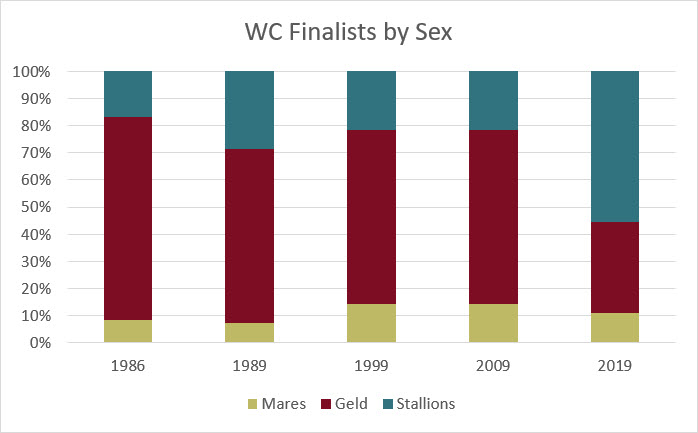
The average age of entrants has held consistently between 13 and 15 years; 1986 had an average age of 15; 1989, 1999 and 2009 all averaged 13 years, while this year’s start list has an average age of 14 years. Interestingly when compared with the showjumpers, it would appear that dressage horses peak two to three years later in their careers, who averaged 11 to 12 years of age.
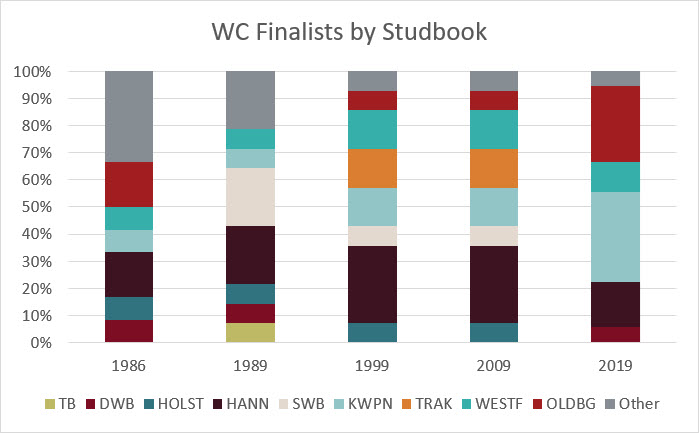
The most evident trend when look at the starters by their respective studbooks is the significant decline of those in the ‘Other’ category. In the inaugural championships of 1986, one entrant was from an undisclosed or unknown (or possibly no!) studbook, one was from Selle Français, and two were branded Lipizzaner. Fast-forward to 2019 and we have just one ‘Other’ studbook, Lusitano represented by the stallion Coroado (Rubi x Luxelia – Xaquiro). Two studbooks have significantly increased in prominence over the period, those being KWPN and Oldenburg. The incidence of Hanovarians in the start list seems to be waning, while the number of respresentatives from Westfalia has remained fairly constant. 2019 saw both Swedish Warmbloods and Holsteiners absent from the line-up. Thoroughbreds made a cameo appearance in the 1989 start list through Prisco, of unrecorded breeding.
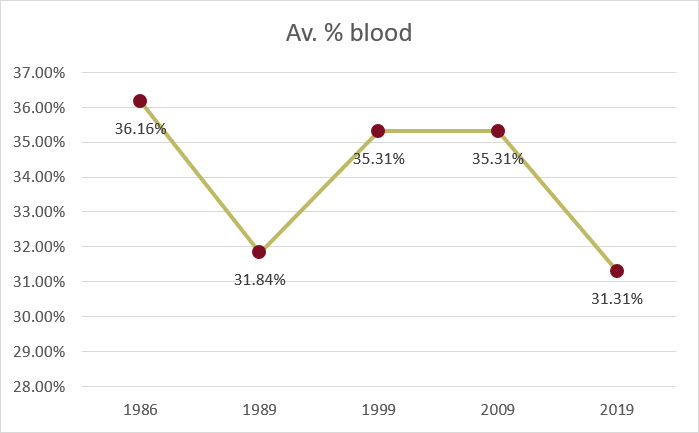
Unlike the wild fluctuations in the percentage of ‘blood’ in the jumping competitors, the dressage horses have sat comfortably in the 31% to 36% band over the entire period. It is unsurprising that the percentage of blood is considerably less than what is seen in the jumping competitors, however I do find it interesting that the mix has not significantly changed in forty years. Have the demands of the sport not changed as has been seen in the jumping ring? Perhaps not. While I am aware of the fad of dressage breeders using some jumping blood to improve the canter, I was quite surprised to see two horses over the five years analysed that were solidly jumping bred both top and bottom: in 1989 we saw Corlandus (Cor de la Bryere x Gustia – Landgraf I), and in 2009 we had Kingston (Voltaire x Gisnette – Burggraaf). This is not a trend that seems to flow both ways, it is extremely rare for a jumping breeder to use a dressage stallion with the aim of producing a 1.60m jumper; that said, flukes do happen!
DRESSAGE START LISTS 1986 to 2019
http://www.horsemagazine.com/thm/wp-content/uploads/2019/04/Dressage-StartlistsONLYtu.pdf


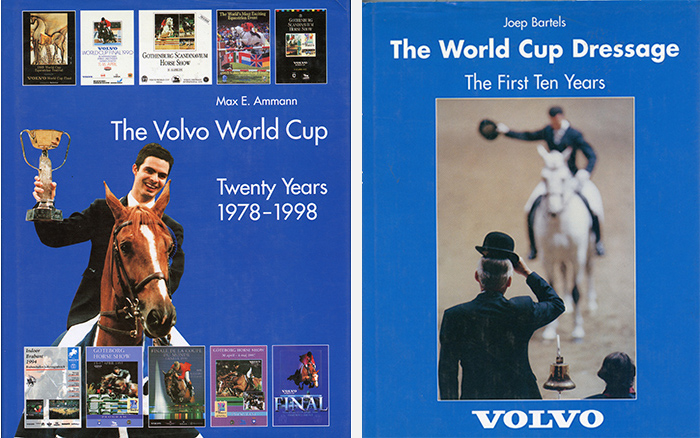
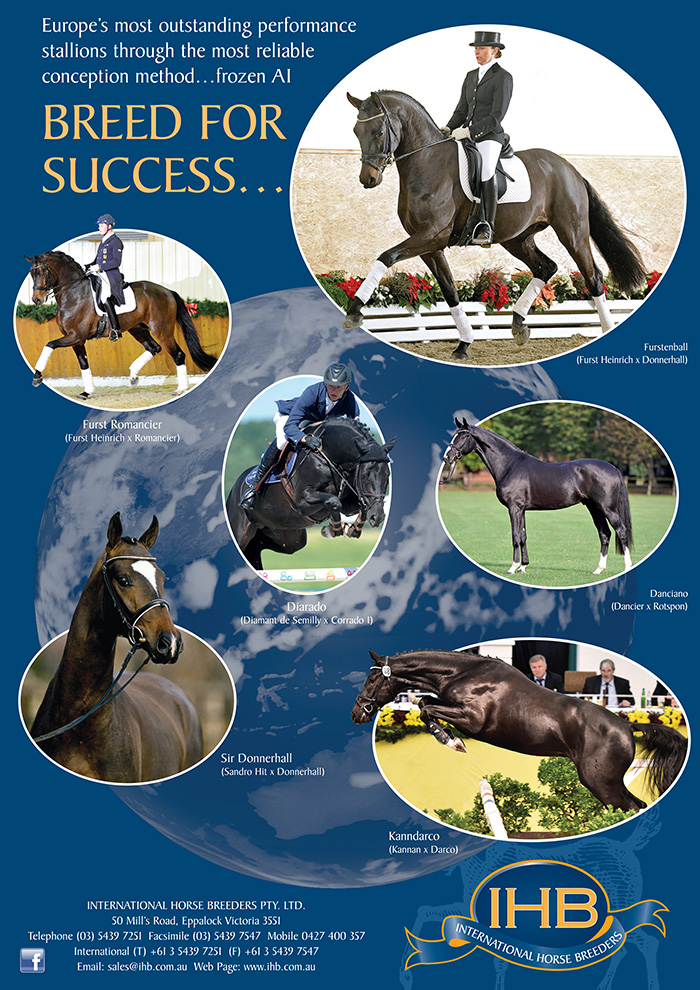
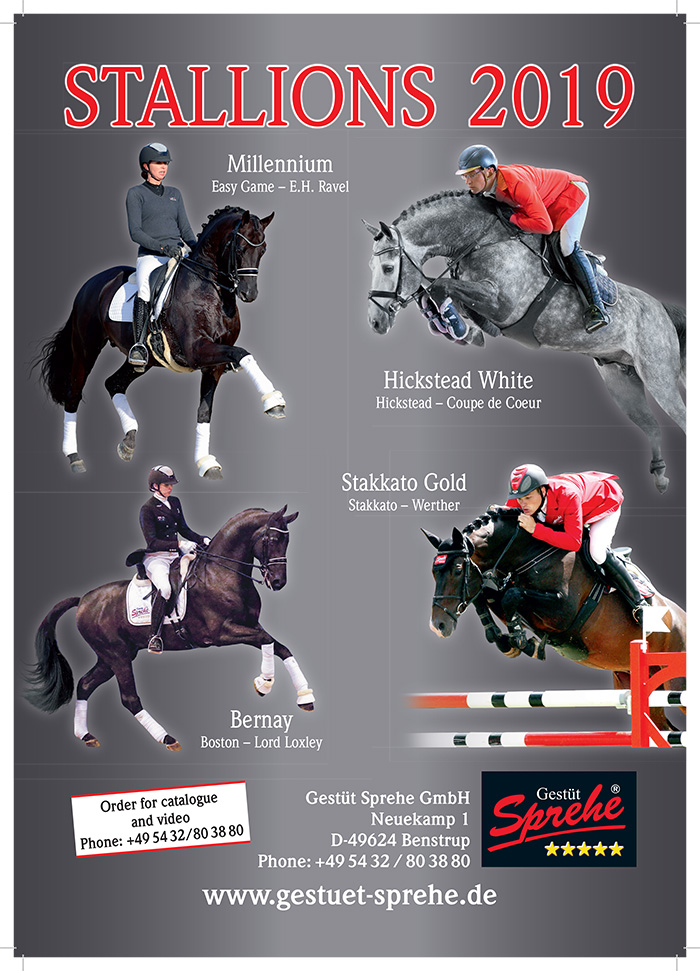
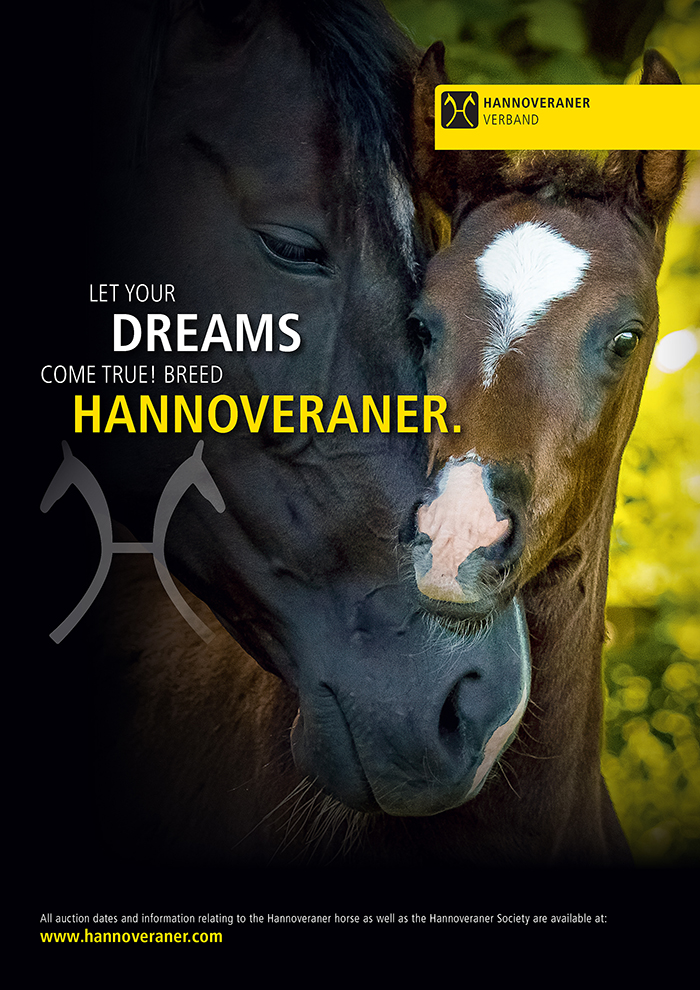
Super article ! Thank you Chris and Gemma